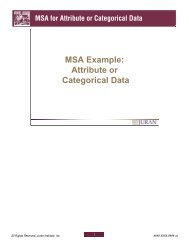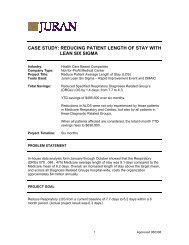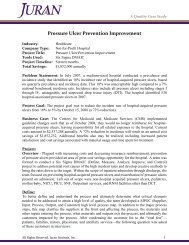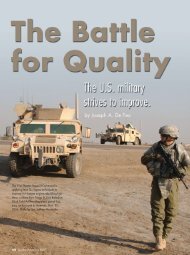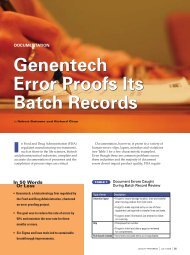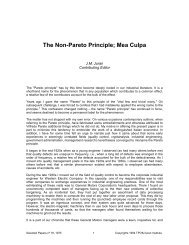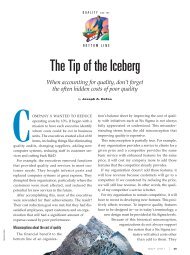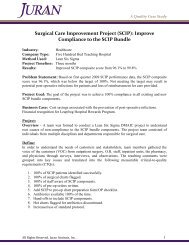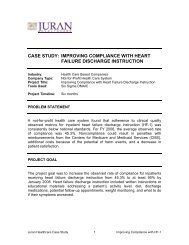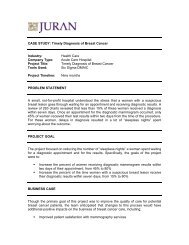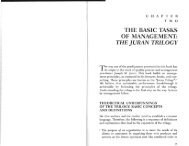Master Black Belt Training Requirements - Juran Institute
Master Black Belt Training Requirements - Juran Institute
Master Black Belt Training Requirements - Juran Institute
You also want an ePaper? Increase the reach of your titles
YUMPU automatically turns print PDFs into web optimized ePapers that Google loves.
http://www.juran.comD. IMP06 Chapter 12: Some Applications of Response Surface MethodsWomack, James P. and Daniel T. Jones (2003) Lean Thinking: Banish Waste and Create Wealthin Your Corporation (Revised and Updated), Free Press, Simon & Shuster, New York, NewYork.A. IMP07 Part I: Lean PrinciplesB. IMP08 Part II: From Thinking to Action- The Lean LeapRother, M. and J. Shook (1999) Learning To See: Value Stream Mapping to Add Value andEliminate Muda, Lean Enterprise <strong>Institute</strong>, Brookline Massachusetts.A. IMP09 What Makes a Value Stream Lean?: Part IIIB. IMP10 Future State Map: Part IVC. IMP11 Achieving the Future State; Part VTapping, D., T. Luyster, and T. Shuker (2002), Value Stream Management: Eight Steps toPlanning, Mapping, and Sustaining Lean Improvements, Productivity, Inc., New York, NewYork.A. IMP12 Step 7: Create Kaizen PlansB. IMP13 Step 8: Implement Kaizen PlansCONTROL/VERIFY PHASE – READING ASSIGNMENTS (CON01 throughCON06)<strong>Juran</strong>, Joseph M. and A. Blanton Godfrey, Co-Editors-in-Chief (1999), <strong>Juran</strong>’s QualityHandbook, Fifth Edition, McGraw-Hill, New York, New York.A. CON01 The Quality Control Process: Section 4B. CON02 Operations: Section 22C. CON03 Statistical Process Control: Section 45D. CON04 Reliability Concepts and Data Analysis: Section 48Box, George E.P., J. Stuart Hunter, and William G. Hunter (2005) Statistics for Experimenters(Second Edition), John Wiley & Sons, Hoboken, New Jersey.A. CON05 Chapter 14: Process Control, Forecasting and Time Series: AnIntroductionB. CON06 Chapter 15: Evolutionary Process OperationAll Rights Reserved <strong>Juran</strong> <strong>Institute</strong>, Inc. 5
http://www.juran.comPART 2: LITERATURE REVIEWFor each phase, conduct a literature review to identify two new references shedding additionalinsight on concepts, tools, methods or applications for each phase. This literature search shouldbe outside of the basic texts and articles used in <strong>Juran</strong> <strong>Institute</strong>'s DMAIC and DMADVworkshops and, preferably, of recent contributions to the field.Part 2 Deliverables:• Hard or electronic (scanned) copies of ten papers (or book chapters) with marginalcomments.• Summary notes in preparation for discussion (with <strong>Juran</strong> <strong>Institute</strong>) of specific insights onconcepts, tools, methods or applications for this phase and ideas on how these may be used inthe MBB candidate's company to further strengthen the Lean or Six Sigma program.Part 3 Deliverables:PART 3: CASE STUDIESTwo case studies of real projects are to be developed. The goal is to use these case studies asflow-through project case studies when teaching a <strong>Black</strong> <strong>Belt</strong> (or Green <strong>Belt</strong> with statistics) waveof projects. The MBB Candidate is expected to use real (or edited if required) projects to developthe case study narrative, data, support files, graphs, MINITAB ® printouts, and questions forbreakout exercises in which the class participants can analyze (using MINITAB ® as appropriate)and discuss as they move through each phase of the training. For example, how would oneconduct an MSA for this project given the context of this project? In a follow-up exercise, afterdata has been “collected” and provided to the participants, they can analyze the data usingMINITAB ® to arrive at their own conclusions on whether the measurement system is valid. Theycan then discuss and propose the correct next steps.Handouts on the breakout exercises (scenario and questions), follow-up data, questions, andanswer keys must be developed. Essentially, the handouts (and supplementary documents) buildthe case study as additional narrative, data, graphs, questions, and exercises become availablethrough each step and each phase of the methodology. In summary, it is a build-up ofinformation (i.e. multiple handouts) as more is known about the case study, similar to whattypically happens in a real project. There should be at least one breakout exercise in Define, andat least two breakout exercises in each of the remaining phases.These teaching case studies will be reviewed and critiqued by a <strong>Juran</strong> specialist as they arebeing developed. Constructive feedback will be given to ensure the quality of the case studyAll Rights Reserved <strong>Juran</strong> <strong>Institute</strong>, Inc. 6
http://www.juran.comfor teaching. In summary, the deliverables are:• Two project case studies with appropriate PowerPoint, Word, Excel and MINITAB ®files, (data files, graphs, charts and output, narratives, questions, breakout exercises).• Answer keys to exercises with data-driven conclusions in appropriate SW format. Forexample, the data and solution to a MINITAB ® related exercise could be placed into theWorksheet (.mtw) and ReportPad portions of a MINITAB ® Project (.mpj).PART 4: MINITAB EXERCISESFor each phase (except Define) demonstrate the use of MINITAB ® on one key tool or method.These applications can be new examples or examples taken directly from <strong>Juran</strong>'s QualityHandbook, Fifth Edition (or one of the other references listed in the <strong>Juran</strong>’s Six Sigma and LeanSix Sigma <strong>Master</strong> <strong>Black</strong> <strong>Belt</strong> Detail <strong>Requirements</strong> – Part 1 in the appendix). The workedexample should contain a brief description of each step taken in MINITAB ® , with a presentationof all plots and graphs and interpretation of output and results. The example must demonstratethe use of the tool in the context of each phase of DMAIC/DMADV.Part 4 Deliverables:• Short description of each of the four examples, copies of data or tables in hard and softcopy, and references and hard copy of MINITAB ® output with all graphs, charts, andanalyses used. Electronic copies of all MINITAB ® worksheets and project files to enablereviewers to verify and replicate analyses.• Summary notes in preparation for discussion with <strong>Juran</strong> <strong>Institute</strong> of example, approach taken,choice of analytic methods, and conclusions.All Rights Reserved <strong>Juran</strong> <strong>Institute</strong>, Inc. 7



